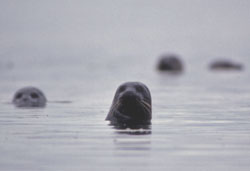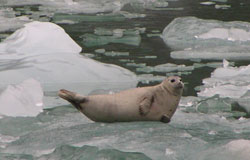Marine Mammal Viewing
Alaska’s marine mammals range from ocean-dwelling creatures, like whales, to those dependent on the oceans for food, like polar bears. To learn more about these animals and where to see them, click on the links below. Be sure to check back as we continue to build the website and add more animals to the list.
To reduce the potential for harm to marine mammals, familiarize yourself with the guidelines and regulations concerning marine mammal viewing.
- Beluga Whales
- Harbor Seals
- Humpback Whales
- Killer Whales
- Polar Bears
- Porpoises and Dolphins
- Sea Otters
Harbor Seal Viewing
Description
 Harbor seals (Phoca vitulina), also known as common or hair seals, are mammals, that is they have hair and are air-breathing animals which suckle their young. They are well adapted to life in the sea, able to dive to depths of up to 1,649 feet (500m), and remain submerged for over 20 minutes.
Harbor seals (Phoca vitulina), also known as common or hair seals, are mammals, that is they have hair and are air-breathing animals which suckle their young. They are well adapted to life in the sea, able to dive to depths of up to 1,649 feet (500m), and remain submerged for over 20 minutes.
Visitors from coastal cities across the Northern Hemisphere will recognize them from their distinctive round heads, big eyes and spotted grey coats.
Harbor seals feed on fish, clams, mussels, and crustaceans like shrimp. They are hunted and preyed upon by sharks and transient killer whales. In May and June, they tend to move to sheltered waterways where each female gives birth to a single pup, often on an iceberg. Harbor seals favor nearshore water and will also swim up rivers.
Habitat
Harbor seals inhabit northern coastal waters. They haul out on sandbars, beaches or ice floes near glaciers.
Viewing
 Harbor seals are widespread in both the north Atlantic and Pacific oceans and are found in Alaska along the coast extending from Dixon Entrance north to Kuskokwim Bay and west throughout the Aleutian Islands. They are most often spotted when their round heads pop quietly above the water surface. Curious but cautious, they are very quiet and rarely vocalize. They tend to swim solo, but concentrations of food can draw them together and they often haul out in groups. Ungainly on land, they look like fat sausages when at rest.
Harbor seals are widespread in both the north Atlantic and Pacific oceans and are found in Alaska along the coast extending from Dixon Entrance north to Kuskokwim Bay and west throughout the Aleutian Islands. They are most often spotted when their round heads pop quietly above the water surface. Curious but cautious, they are very quiet and rarely vocalize. They tend to swim solo, but concentrations of food can draw them together and they often haul out in groups. Ungainly on land, they look like fat sausages when at rest.
